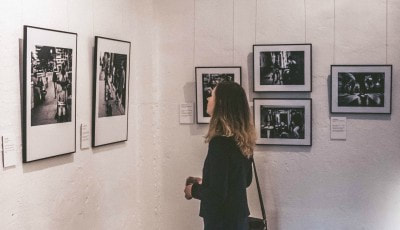 Hello! Welcome to my blog, “Left Brain Skills for Right Brained People” I’m a Career & Life Coach for artists and other creative people. I’m based in the San Francisco Bay Area but work with artists throughout the U. S. and all over the world. This is the sixth installment of my blog, where we’re reviewing a checklist of 10 behaviors that are characteristic of successful artists. Use the checklist below to see how you’re doing. Checklist for a Successful Art Career (26 KB) Don’t worry—nobody does everything every day. The goal is to build more of these behaviors into your own life, whenever you can. Let’s take a look at #6: “I’m good at talking about my art.” Sometimes artists think that they shouldn’t have to find the words to “explain” their art, but they do! Many opportunities to promote yourself come at you in a random way. You meet someone at an art event, or a family reunion, or even at the gym. When they find out you’re an artist, they might ask you about your work. The first time this happens, you’ll probably freeze and mumble and avoid the question, because you’re not prepared. To make the most of such opportunities, you need to be ready with three or four clear sentences that describe your work. These comments should feel natural, and be in your own voice, not in art school language. Here are two “before” and “after” versions of artists talking about their work. Question: “Oh, you’re an artist. What kind of art do you make?” First answer: “Oh well, I sort of work with stuff I find, like old papers and things ….. and I make art out of it.” The artist, unprepared, doesn’t sound like she wants to talk about her work and the questioner wandered off, seeming a bit disappointed. Here’s a better response: “I make collages from paint and paper and materials I collect. First I paint colorful shapes, and then add unusual materials, like old wallpaper I find at antique stores. Sometimes I call these works “urban landscapes” because they have a kind of gritty feel.” Notice how much information the artist has packed into her three sentences. She keeps the tone easy and conversational, but offers interesting detail about her process and materials. She uses an art world term, “urban landscapes,” but explains what it means. Here’s another example. This artist was talking with a gallery owner about his work: First try: “I call this my water series, because it is inspired by my concern for the environment. Each painting explores a different aspect of our relationship to nature.” While the artist sounds serious, he isn’t very specific. His description could apply to thousands of artists who depict the natural world. After a couple of rehearsals, here’s what he came up with: “My water series is about the effects of climate change on the San Francisco Bay. In this painting you see abstract shapes that look like separate pieces of land floating together, but they are actually disconnected from each other. At first glance is looks like a pleasant harbor, but when you look closely you get a sense of dislocation, that something has gone wrong here ….” In this second attempt the artist draws attention to details in the painting. Instead of talking about general ideas, like the environment, he reveals how his own work creates a specific meaning. Talking about your art is important because it makes people want to look at it, or look at it longer. Think about your experience with a good docent at a museum. Instead of putting you to sleep with a lecture on art history, good docents point out details in style, materials, and subject matter, and use those details to help you understand how the work conveys its meaning. When you talk well about your art, you help the viewer see it. Remember, nobody falls in love with a work of art, or considers buying it, unless they look at it for a considerable length of time. In the next blog I’ll consider question #7 on the checklist, “My work has a signature style or content.” ~ Mary Mary Edwards, Ph.D. Career & Life Coach for Artists Comments are closed.
|
Mary's BlogAs an artist coach, I bring a unique combination of business knowledge, art world experience, and professional coaching skill to my practice. |